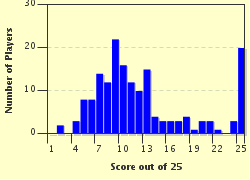Quiz Answer Key and Fun Facts
1. A: The larval form of the lacewing is known by many names around the world, and several of them reference its voracious appetite. What are these larva called?
2. B: This large fish lives mainly in the warm, shallow coastal waters of the southern hemisphere. However, they aren't picky when it comes to water conditions, and have been seen in some rather unexpected places! What is it?
3. C: A greenish-brown amphibian with a light yellow throat and belly, this animal lives higher than most of its relatives - rarely below 2,000 feet - in the mountain ranges of its natural habitat. What is it called?
4. D: Endemic to Madagascar, what species of primate was once described by naturalist Russell Mittermeier as "one of the most colorful and attractive of all the lemurs"?
5. E: What bird, sacred to ancient Egyptian culture, once had a range that spanned from southwestern Europe to the Indian subcontinent, and south to the central parts of Africa?
6. F: This is the largest true cobra in Africa, and can grow, on average, to 7.2 feet (2.2 meters). What is it?
7. G: The graylag (or greylag) goose is one of the many species of geese that populate the world. Which of these is not true of it?
8. H: Endemic to the western coast of North America, this shark is one of the bullhead family. They are considered clumsy swimmers, and prefer to push themselves along the seafloor rather than swimming. Which shark is this?
9. I: The Indian hog deer is a small deer that is native to a large part of the Asian continent and has been introduced in several other countries. Which of these countries does not have an introduced (or feral) population?
10. J: Also known as the postsitter, what sort of animal is the jacky winter?
11. K: If you're easily grossed out, perhaps the Kerry slug isn't your best bet - it can reach lengths of up to 3.2 inches (8.12 centimeters). You'll be sure to avoid them though, if you stay away from which continent?
12. L/M: The lion-tailed macaque is a rather unusual-looking specimen, with its name being well deserved. Since it is endemic to a single country, where would I buy tickets to if I wanted to see one in the wild?
13. N: The Nubian ibex is endemic to Ethiopia.
14. O: As suggested by the name, Orinoco crocodiles live mainly in the Orinoco river; what continent does this put them on?
15. P: The pearlscale butterflyfish is a striking reef-dweller. A diurnal species, which ocean would I go diving in if I wanted to see one of these ocean beauties?
16. Q: Queen Alexandra's birdwing is a species of butterfly endemic to one region of Papua New Guinea.
17. R: A critically endangered species by IUCN standards, the Roti Island snake-necked turtle lives on only one island - Roti (also spelled Rote) Island. Which of the following best describes this creature's natural habitat?
18. S: Seal salamanders are a type of lungless salamander that inhabit the streams of part of the United States. In which of the following states would you not find a native population?
19. T: Which of the following is a North American freshwater snail?
20. U: The Uncompahgre fritillary is a fairly new species for science. First discovered in 1978 by college students, where in the world does this butterfly call home?
21. V: Variable bush vipers are native to parts of both Europe and Asia.
22. W: Wyoming toads, like many other animals, have more than one common name; which of the following is an alternate name for this creature?
23. X: Xantus' hummingbird is one of several species of hummingbird - or any other animal, for that matter! - to be named in honor of something or someone. Which of the following was this little bird named after?
24. Y: The Yaqui chub is a freshwater fish, native to parts of North America. Which of these options best describes this fish's size?
25. Z: This bird is endemic to a peninsula on the island nation of Cuba, and is the only member of its genus. What is it?
Source: Author
NovaLuna
This quiz was reviewed by FunTrivia editor
guitargoddess before going online.
Any errors found in FunTrivia content are routinely corrected through our feedback system.


